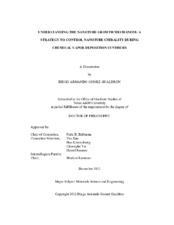| dc.description.abstract | For two decades, single-wall carbon nanotubes (SWCNTs) have captured the attention of the research community, and become one of the flagships of nanotechnology. Due to their remarkable electronic and optical properties, SWCNTs are prime candidates for the creation of novel and revolutionary electronic, medical, and energy technologies. However, a major stumbling block in the exploitation of nanotube-based technologies is the lack of control of nanotube structure (chirality) during synthesis, which is intimately related to the metallic or semiconductor character of the nanotube.
Incomplete understanding of the nanotube growth mechanism hinders a rationale and cost-efficient search of experimental conditions that give way to structural (chiral) control. Thus, computational techniques such as density functional theory (DFT), and reactive molecular dynamics (RMD) are valuable tools that provide the necessary theoretical framework to guide the design of experiments. The nanotube chirality is determined by the helicity of the nanotube and its diameter.
DFT calculations show that once a small nanotube 'seed' is nucleated, growth proceeds faster if the seed corresponds to a high chiral angle nanotube. Thus, a strategy to gain control of the nanotube structure during chemical vapor deposition synthesis must focus on controlling the structure of the nucleated nanotube seeds. DFT and RMD simulations demonstrate the viability of using the structures of catalyst particles over which nanotube growth proceeds as templates guiding nanotube growth toward desired chiralities. This effect occurs through epitaxial effects between the nanocatalyst and the nanotube growing on it. The effectiveness of such effects has a non-monotonic relationship with the size of the nanocatalyst, and its interaction with the support, and requires fine-tuning reaction conditions for its exploitation.
RMD simulations also demonstrate that carbon bulk-diffusion and nanoparticle supersaturation are not needed to promote nanotube growth, hence reaction conditions that increase nanoparticle stability, but reduce carbon solubility, may be explored to achieve nanotube templated growth of desired chiralities. The effect of carbon dissolution was further demonstrated through analyses of calculated diffusion coefficients. The metallic nanocatalyst was determined to be in viscous solid state throughout growth, but with a less solid character during the induction/nucleation stage. | en |


